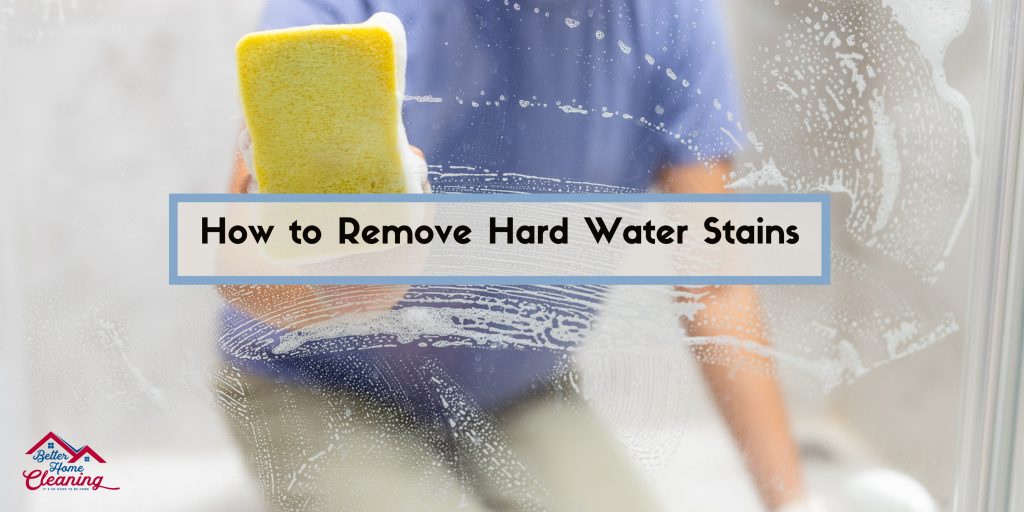How to Remove Hard Water and Shower Stains

Fighting hard water stains in the bathroom? Use our step by step guide to remove hard water and shower stains in the bathroom.
With how often the bathroom is used in every household, it’s no wonder they can be difficult to clean. Hard water stains frequently return and lead to a frustrating cleaning experience. Lets simplify the process and walk through each step so that you can enjoy a cleaner bathroom.
Hard Water in Shower/Tub
With water running frequently in bathrooms, hard water stains are sure to follow. Pay attention to the color of the stains in the bathroom to treat them effectively. Find a detailed guide for cleaning shower tile here.
Yellow Stains
Yellow stains can appear in the tub/shower, faucets or shower curtain usually caused by hard water, body oils or from mildew build up.
For a basic clean, you’ll need the following supplies:
- Rubber gloves
- Warm water with a squirt of dish soap (dish soap solution)
- Spray bottle with half dish soap solution, half white vinegar
Spray on stains, let it sit for 5-10 minutes, scrub, rinse and repeat if necessary.
If stains persist, try a more aggressive approach:
- Make a paste with 2 parts baking soda to 1 part hydrogen peroxide. Create a paste that is spreadable but not runny.
- Spread it on the stain and let it sit for 10 minutes.
- Scrub with a soft sponge or brush.
You can also lay a damp towel soaked in vinegar on the stain and let it soak for hours or overnight. Follow with scrubbing and a hot rinse.
Pink Stains
Pink staining in the bathroom usually comes from the bacteria Serratia Marcescens. Staining is often found in toilet bowls, shower curtains, around drains, or on bathroom walls.
Since pink stains are a form of mold, it’s important to wear protective gear when cleaning. Grab some rubber gloves, a face mask, and eye protection. Luckily, pink mold can be cleaned with non-toxic ingredients:
- Liquid dish soap
- Distilled white vinegar
- Baking soda
- Spray bottle
- Scrub brush
Before cleaning, turn on the exhaust fan and open any windows to improve air circulation while you clean.
- If there is any pink/orange coloring on the shower curtain, throw in the washing machine or wash it by hand.
- Rinse areas with pink staining in the hottest water possible.
- Make a paste with 4 parts baking soda and one part liquid dish soap.
- Use a brush to scrub the stained areas and rinse.
- Mix 1 part water with 1 part vinegar in a spray bottle.
- Apply to the entire shower/tub and let it sit for 10 minutes. Scrub any visible stains and rinse.
How to Prevent Pink Mold
- Rinse the walls of the shower with hot water after each use to reduce soap residue.
- Wipe down walls with a towel or squeegee after each use.
- Only use bath rugs that dry quickly and have antibacterial properties.
How to Keep Hard Water Away
Regular maintenance and cleaning is key to preventing hard water build up throughout your home. If there is no water softener in the home, have one installed. If there is still hard water stains with a water softener, make sure it is working properly and maintain it regularly
How to Maintain Water Softener
If you find hard water build up, check each of these items to ensure your water softener is working at its best:
- Use quality salt and check salt levels regularly.
- Clean the brine tank every 6-12 months, do this when the salt supply is low.
- Clean the venturi valve with soapy water twice a year.
- Inspect the resin tank for leaks.
How Often to Clean Shower Head
Whenever the water flow is reduced, the showerhead should be cleaned immediately. To prevent reduced water flow, set a reminder on your phone to clean it at least once a month. Regular cleaning means less mold and bacteria growth inside the shower head.
If you find that your bathrooms still need extra attention, give us a call today. We are happy to give you a cleaner bathroom and home to enjoy!
